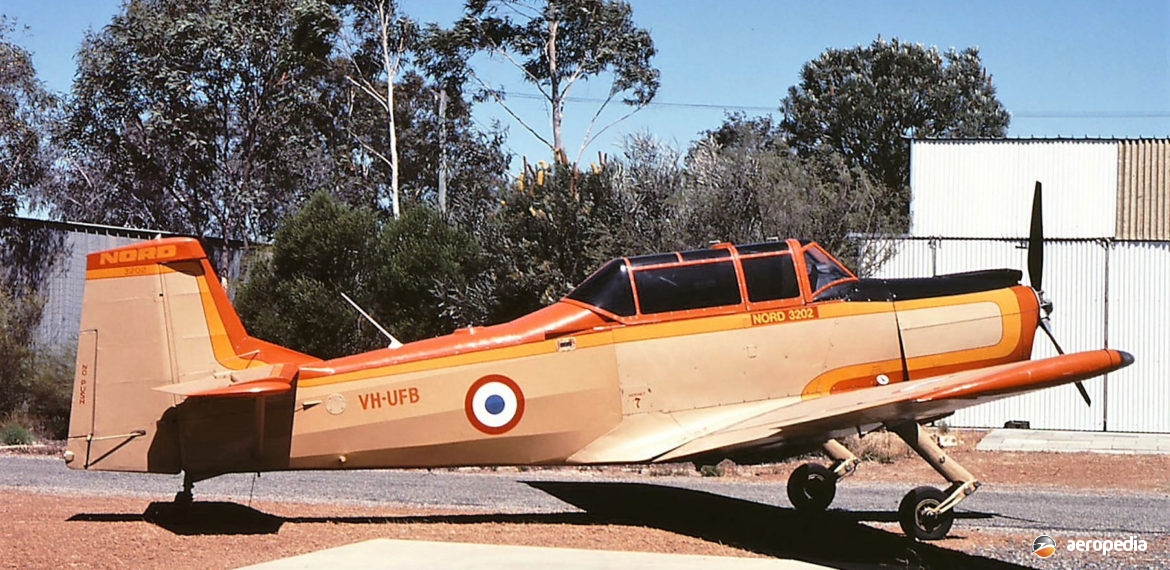Photograph:
Nord 3202 VH-UFB (c/n 97) at Serpentine, WA (Neville M Parnell)
Country of origin:
France
Description:
Two-seat military primary trainer
Power Plant:
One 194 kw (260 hp) Potez 4D-34B four-cylinder in-line inverted supercharged air-cooled engine
Specifications:
- Wingspan: 9.5 m (31 ft 2 in)
- Length: 8.12 m (26 ft 7¾ in)
- Height: 2.82 m (9 ft 3 in)
- Wing area: 16.26 m² (175 sq ft)
- Max speed at sea level: 260 km/h (161 mph)
- Cruising speed at 1,300 m (4,265 ft): 249 km/h (155 mph)
- Max cruising speed at 2,300 m (7,545 ft): 235 km/h (146 mph)
- Stalling speed flaps down: 102 km/h (63 mph)
- Initial rate of climb: 360 m/min (1,181 ft/min)
- Minimum speed: 83 km/h (51.5 mph)
- Normal range at 2,300 m (7,545 ft): 1,000 km (620 miles)
- Empty weight: 824 kg (1,813 lb)
- Loaded weight: 1,220 kg (2,690 lb)
History:
The Nord 3202 was manufactured by SNCA du Nord in France as a two-seat primary trainer for use as standard equipment at schools of the Aviation Legere de l’Armee (ALAT), replacing the Stampe SV-4 biplane. Flown for the first time on 17 April 1957, the initial production series, known as the Nord 3202, which was a development of the 3200 and 3201, was fitted with a supercharged Potez 4D-32 engine, fifty aircraft being fitted with this engine before production switched to a further fifty aircraft fitted with the Potez 4D-34B unit of 194 kw (260 hp) in lieu of 179 kw (240 hp) of the earlier unit, driving a three-blade constant-speed Hartzell propeller. Production of the series concluded in 1961. The type saw service in the basic flying instruction, aerobatics, and blind flying roles. A variant was the Nord 3212, similar except for being fitted with a radio compass.
The 3200 was a civilian derivative aimed at the aerobatic, touring and pilot training market and was fitted with an inverted 186 kw (250 hp) Salmson VEE eight-cylinder 8AS-04 engine and followed shortly after the 3201. The 3202 was chosen as the standard basic training, aerobatic and blind-flying instruction aircraft for the Aviation Legere de l’Armee de Terre, which was basically the French version of the Army Air Corps in Britain. The type was progressively withdrawn from service between 1973 and 1975 and an American operator obtained thirty examples. The 3202 was used by the French aerobatic team at the 1966 World Aerobatic Championships in Moscow, one achieving 9th place overall.
The 3202 has been described as a “very rewarding aeroplane, and extremely satisfying when you land it correctly. It possesses good short-field characteristics and can be safely operated off just a few hundred metres of grass if required”. The fuselage was of welded steel tube structure covered with metal panels forward, and fabric aft. The wing was a one-piece metal monospar structure covered with fabric. The trailing edge flaps and ailerons were fabric covered. The undercarriage was unusual in being a ‘kneeling’ fixed unit secured to the mainspar. Fuel was carried in a single 173 litre (38 Imp gal) fuel tank in the fuselage.
A Nord 3202 was imported into Australia in 1992. Previously registered in the United States as N2756W, and in France as F-MAIP, it became VH-UFB (c/n 97) in May 1992 and is based in Western Australia at Serpentine. Since the type’s withdrawal from military service, a number have become available to private owners and a few are registered in the United States and Great Britain. In 2008 two further examples were imported and registered, one becoming VH-IWD (c/n 93) to its owner at Baldivis, WA, and the other becoming VH-JMV (c/n 06308) to Kaldumb Pty Ltd of Leongatha, VIC. In February 2012 a further example became VH-JUD (c/n 73) to Gecam Operations of Leongatha, VIC.

